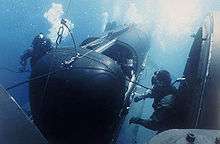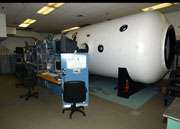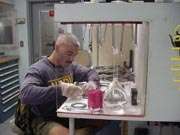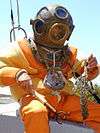United States Navy Experimental Diving Unit
| Navy Experimental Diving Unit | |
|---|---|
 | |
| Active | 1927 |
| Country |
|
| Branch |
|
| Role | NEDU is the primary source of diving and hyperbaric operational guidance for the US Navy. |
| Size | 120+ |
| Part of | U.S. Naval Sea Systems Command (NAVSEA) |
| Garrison/HQ | US Naval Support Activity, Panama City Beach, Florida |
| Commanders | |
| Current commander | Commander Mark Matthews |
The United States Navy Experimental Diving Unit (NEDU or NAVXDIVINGU) is the primary source of diving and hyperbaric operational guidance for the US Navy.[1][2][3] It is located within the Naval Support Activity Panama City in Panama City Beach, Bay County, Florida.[3]
Mission and Vision
NEDU describes its mission as: "The Navy Experimental Diving Unit tests and evaluates diving, hyperbaric, and other life-support systems and procedures, and conducts research and development in biomedical and environmental physiology. NEDU provides technical recommendations based upon knowledge and experience, to Commander, Naval Sea Systems Command to support operational requirements of our armed forces."[3]
The vision for NEDU is stated to be: "The Navy Experimental Diving Unit will be the most credible and respected research, development, and test and evaluation center for diving as well as the focal point of leadership for biomedical and bioengineering solutions for undersea military operations."[3]
History
Brooklyn Navy Yard
Experimental diving in the US Navy started in 1912 at the Brooklyn Navy Yard under the leadership of Chief Gunner George D. Stillson.[1] Stillson's research program ultimately led to increasing diver capabilities from 60 feet (18 m) to over 300 feet (91 m) of depth based on Haldane's decompression work with the Royal Navy. This resulted in the first publication of the United States Navy Diving Manual and established the need for a facility dedicated to research and development of diving procedures.[1][4][5]
In 1915, Stillson's team was sent to salvage the F-4 submarine. On these deep dives, the divers experienced the debilitating effects of nitrogen narcosis leading them to try the addition of helium to their breathing mix.[2] The navy salvage operations then came under the direction of Warrant Gunner C. L. Tibbals who led teams through the salvage of the S-51 in 1925 and S-4 in 1927 further establishing the naval need for equipment, training, and procedures for rescue operations.[2]
Washington Navy Yard
NEDU was established in 1927 at the Washington Navy Yard.[1][2]

Early developments for the unit involved evaluation and testing of the Submarine Escape Lung (Momsen lung) and the McCann Rescue Bell.[2] This work was done by Charles Momsen and Allan McCann. In 1929, Momsen received the Navy Distinguished Service Medal for personally testing the device at a depth of 200 feet (61 m). Techniques used for the rescue of submariners aboard the USS Squalus were developed by Momsen and McCann in their time at NEDU.[2][6][7] This work lead to the rescue and recovery of 33 crewmen.[6] Momsen and McCann received a Letter of Commendation from President of the United States Franklin D. Roosevelt for the Squalus effort.[6]
The first medical staff were introduced to the facility in the mid-1930s when Charles W Shilling, Albert R Behnke, and OE Van der Aue began work. Their early work improved the prevention and treatment of decompression sickness with the inclusion of oxygen rather than air.[1][8][9]
Through World War II, work continued on decompression and oxygen toxicity.[10][11]
Through the 1950s NEDU tested equipment and further refined procedures for divers including the US Navy 1953 decompression table.[12][13]
From 1957 to 1962 was the beginnings of saturation diving under the leadership of Captain George F. Bond of the Naval Submarine Medical Research Laboratory and the Genesis Project.[1][14] Genesis D was performed at NEDU in 1963.[1][15] Bond then went on to head the SEALAB I saturation project in 1964.[16]
Robert D. Workman published a novel method to calculate decompression schedules in 1965 that involved estimating the limiting values of excess tissue supersaturation.[17]
Work continued in deep saturation dives, equipment testing as well as thermal protection and physiology research throughout the 1960s and early 1970s.
Naval Support Activity Panama City
In 1975, NEDU relocated to its current location in Panama City, Florida.[1]
%2C_is_fitted_with_a_Kirby_Morgan_37_Dive_Helmet.jpg)
NEDU tested and evaluated the replacement of Stillson's Mark V as the US Navy standard diving dress, the Mark 12 Surface Supplied Diving System, and eventually its replacement the Mark 21/ Superlight 17 in the 1970s and 1980s.[1][18][19]
NEDU conducts at least one saturation dive per year. These dives were used, amongst other things, to evaluate decompression and recompression procedures, equipment, carbon dioxide absorbents, as well as active and passive thermal protection.[20][21][22] Many of these tests included ongoing evaluations of commercially available diving equipment.[23][24][25]
In 1998, the Naval Medical Research Center's diving biomedical and development group was transferred to NEDU.[1][26]
In response to the overseas military needs, NEDU focused on warm water diving from 1999 to 2002.[27] This guidance to the Naval Special Warfare community influences operational needs on an ongoing basis.[1]
NEDU divers were essential to the recovery of artifacts from the ex-USS Monitor in 2001 and 2002.[1][28]
In 2002, certification of the Mark 16 Mod 1 rebreather was completed following improvement of systems including, extension of the working limit to 300 feet (91 m), new decompression tables for both nitrogen-oxygen and helium-oxygen diving including new repetitive diving capabilities for helium-oxygen, test of an Emergency Breathing System with communications, the addition of an integrated buoyancy compensation device, and an improved full face mask.[1][29]

In 2004, NEDU contributed to operational guidance for diving in harsh contaminated environments.[30]
NEDU has continued research into oxygen toxicity utilizing the US Navy Mark 16 Mod 1.[31][32]
Development of breathing systems, thermal protection, and decompression procedures for SEAL Delivery Vehicles and the Advanced SEAL Delivery System is ongoing.[33][34]
In 2011, divers completed a 1,000 fsw saturation dive to evaluate the new Navy's Saturation Fly-Away Diving System (SAT FADS).[35] The SAT FADS was designed in 2006 as a portable replacement of two decommissioned Pigeon-class submarine rescue vessels.[35]
Evaluation and testing of new breathing apparatus and application of other technologies for diving is key to their mission.[36][37]
Facilities
Ocean simulation facility

The Ocean Simulation Facility (OSF) simulates ocean conditions to a maximum pressure equivalent of 2,250 feet (690 m) seawater (fsw) at any salinity level. The chamber complex consists of a 55,000-US-gallon (210,000 L) wet chamber and five interconnected dry living/working chambers totaling 3,300 cubic feet (93 m3) of space. Wet and dry chamber temperatures can be set from 28 to 104 °F (−2 to 40 °C). Equipped with the latest data acquisition capability, the OSF can accommodate a wide range of complex experiments including diver biomedical studies and testing of humans as well as small submersible vehicles and other machines in the wet chamber. Saturation dives can be performed for more than 30 days of continuous exposure in the OSF. For human and equipment testing underwater over extended periods, divers use the dry chambers as comfortable living quarters, from which they can make diving excursions into the wet chamber. The dry chambers are also capable of altitude simulation studies to heights of 150,000 feet (46,000 m).[38]
Experimental test pool

The Experimental Test Pool is a 50,000-US-gallon (190,000 L) capacity freshwater tank measuring 15 ft (4.6 m) by 30 ft (9.1 m) by 15 ft (4.6 m) deep, capable of sustaining temperatures from 34 to 105 °F (1 to 41 °C). It is designed and constructed for manned, shallow water testing and for supporting workup dives for the Ocean Simulation Facility. The test pool is supported by a fully instrumented medical and engineering deck, from which the safety of both divers and test equipment can be monitored. The facility can accommodate a wide range of experiments, from biomedical studies of diver thermal and workload conditions to equipment studies of submersible devices. The test pool has a communications suite, full video capability, real-time computerized data acquisition and analysis, and pressure and gas monitoring.[39]
The depth is sufficient to allow divers to maintain an oxygen partial pressure of 1.3 bar on their breathing apparatus while immersed and riding a bicycle ergometer.[31][32]
Environmental chamber

The Environmental Chamber is capable of simulating a broad range of temperatures from 0 to 130 °F (−18 to 54 °C), humidity from 5 to 95%, and wind velocity from 0 to 20 mph (0 to 32 km/h). The chamber is instrumented to conduct physiological studies and to test various types of equipment.[40]
Experimental diving facility

The Experimental Diving Facility (EDF) simulates unmanned pressure conditions to 1,640 feet (500 m) sea water and temperatures can be set from 28 to 110 °F (−2 to 43 °C). As a complement to the Ocean Simulation Facility, the EDF is used to conduct unmanned testing and evaluation of diving and hyperbaric chamber systems and components. All diving practices and procedures are tested to determine their safety, conformance to established standards, and operational suitability and limits.[41][42]
Class 100,000 clean room

Operated by certified technicians, the Class 100,000 Clean Room performs a variety of cleaning and testing tasks: oxygen cleaning of piping, valves, regulators, tanks, and filters, as well as hydrostatic testing up to 10,000 psi (69,000 kPa). All components used in diving life-support systems are cleaned and certified to meet military standards.[43][44][45]
Gas analysis lab

The gas analysis laboratory is equipped for the precise analysis of gases, and it is used to evaluate diving-related problems such as offgassing and contaminant control. The laboratory’s analytical capabilities include gas chromatography, mass spectrometry, and infrared spectroscopy. The facility is currently used to develop reliable and rapid screening methods and analyzers for the Fleet.[44][45][46]
Cardiopulmonary lab
The cardiopulmonary laboratory consists of machines that perform a myriad of respiratory function tests and aerobic performance measurements that are often recorded before and after pressure and/or thermal exposure.[47]
Library
The NEDU Library contains over 120,000 documents on diving medicine, engineering, and history from around the world.[48] Many of the NEDU publications have been scanned and are available online at the Rubicon Research Repository.[49] Other articles can be found in the Duke University Medical Center Archive finding aids of the Undersea and Hyperbaric Medical Society library collection.[50]
Personnel
The 120 person NEDU Team includes highly qualified and experienced military divers with a combined 1,000 man-years of diving experience: Sea-Air-Land (SEAL), Explosive Ordnance Disposal (EOD), Salvage, Saturation, Seabee, Diving Officer, and Diving Medical Officer (DMO), Ph.D. scientists, engineers, various science-degreed professionals and support personnel.[51]
References
- 1 2 3 4 5 6 7 8 9 10 11 12 13 Tranchemotagne, M (2003). "NEDU Celebrates 75 Years" (PDF). Faceplate 7 (1): 4–5. Retrieved 2008-09-09.
- 1 2 3 4 5 6 Carter Jr, RC (1977). "Pioneering Inner Space: The Navy Experimental Diving Unit's First 50 Years". US Navy Experimental Diving Unit Technical Report. NEDU-1-77. Retrieved 2008-09-09.
- 1 2 3 4 NEDU. "Navy Experimental Diving Unit". Navy Experimental Diving Unit. Retrieved 2008-09-09.
- ↑ Stillson, GD (1915). "Report in Deep Diving Tests.". US Bureau of Construction and Repair, Navy Department. Technical Report. Retrieved 2008-09-09.
- ↑ Boycott, A. E.; G. C. C. Damant; J. S. Haldane (1908). "The Prevention of Compressed-air Illness". J. Hygiene 8 (3): 342–443. doi:10.1017/S0022172400003399. PMC 2167126. PMID 20474365. Retrieved 2008-09-09.
- 1 2 3 Maas, Peter (1999). The Terrible Hours: The Man Behind the Greatest Submarine Rescue in History. New York: HarperCollins Publishers. ISBN 978-0-06-019480-2. OCLC 41504915.
- ↑ Momsen, C. (1942). "Report on Use of Helium Oxygen Mixtures for Diving". US Naval Experimental Diving Unit Technical Report (42–02). Retrieved 2008-09-09.
- ↑ Behnke, AR; Willmon, TL (1940). "Preliminary Report on Aeroembolism and Equipment for Oxygen Inhalation". US Navy Experimental Diving Unit Technical Report. NEDU-1-40. Retrieved 2008-09-09.
- ↑ Van Der Aue, OE; White Jr, WA; Hayter, R; Brinton, ES; Kellar, RJ (1945). "Physiologic Factors Underlying the Prevention and Treatment of Decompression Sickness". US Navy Experimental Diving Unit Technical Report. NEDU-1-45. Retrieved 2008-09-09.
- ↑ Behnke A. R., Johnson F. S., Poppen J. R., and Motley E. P. (1935). "The effect of oxygen on man at pressures from 1 to 4 atmospheres". Am J Physiol 110 (3): 565–572. Retrieved 2008-09-09.
- ↑ Yarbrough, OD; Welham, W; Brinton, ES; Behnke, AR (1947). "Symptoms of Oxygen Poisoning and Limits of Tolerance at Rest and at Work". US Navy Experimental Diving Unit Technical Report. NEDU-1-47. Retrieved 2008-09-09.
- ↑ Fulton, HT; Welham, W; Blockwick, TN (1951). "Nitrogen-Oxygen Self-Contained Underwater Breathing Equipment". US Navy Experimental Diving Unit Technical Report. NEDU-8-51. Retrieved 2008-09-09.
- ↑ Lanphier, EH; Dwyer, JV (1954). "Diving with Self-Contained Underwater Breathing Apparatus. Reports 1 - 11". US Navy Experimental Diving Unit Technical Report. NEDU-54-1 to 11. Retrieved 2008-09-09.
- ↑ Workman, Robert D; Bond, George F; Mazzone, Walter F (1967). "Prolonged exposure of animals to pressurized normal and synthetic atmospheres". Naval Submarine Medical Research Lab Technical Report (NSMRL–374). Retrieved 2010-01-29.
- ↑ Miller, James W; Koblick, Ian G (1984). Living and working in the sea. Best Publishing Company. p. 432. ISBN 1-886699-01-1.
- ↑ Workman, RD (1965). "Calculation of decompression schedules for nitrogen-oxygen and helium-oxygen dives". US Navy Experimental Diving Unit Technical Report. NEDU-6-65. Retrieved 2008-09-09.
- ↑ Coulombe, MA (1978). "MK 12 Surface Supported Diving System (MK 12 SSDS) Mixed Gas, Technical Evaluation". US Navy Experimental Diving Unit Technical Report. NEDU-19-78. Retrieved 2008-09-09.
- ↑ Curley, MD (1986). "Human Factors Evaluation of the Superlite 17B Helmet in the Surface- Supplied, Open-Circuit Mode". US Navy Experimental Diving Unit Technical Report. NEDU-11-85. Retrieved 2008-09-09.
- ↑ Thalmann, E. D. (1985). "Development of a Decompression Algorithm for Constant Oxygen Partial Pressure in Helium Diving". US Navy Experimental Diving Unit Technical Report. NEDU-1-85. Retrieved 2008-09-09.
- ↑ Zumrick Jr, JL (1984). "Manned Evaluation of the MK-15 UBA (Underwater Breathing Apparatus) Canister Duration in 13 C Water Using a Resting Diver Scenario". US Navy Experimental Diving Unit Technical Report. NEDU-2-84. Retrieved 2008-09-09.
- ↑ Clarke, JR; Thompson, LD; Godgrey Jr, RJ (1998). "Lot Variability of Sofnolime 408 Carbon Dioxide Absorbent When Tested in the Cold". US Navy Experimental Diving Unit Technical Report. NEDU-01-98. Retrieved 2008-09-09.
- ↑ Middleton, JR (1980). "Evaluation of Commercially Available Buoyancy Compensators". US Navy Experimental Diving Unit Technical Report. NEDU-1-80. Retrieved 2008-09-09.
- ↑ Middleton, JR (1980). "Evaluation of Commercially Available Open Circuit Scuba Regulators". US Navy Experimental Diving Unit Technical Report. NEDU-2-80. Retrieved 2008-09-09.
- ↑ Sterba, JA; Hanson, RS; Stiglich, JF (1989). "Insulation, Compressibility and Absorbency of Dry Suit Undergarments". US Navy Experimental Diving Unit Technical Report. NEDU-10-89. Retrieved 2008-09-09.
- ↑ Department of the Navy (1995). "Defense Base Closure and Realignment Commission 1995 Report to the President : Naval Medical Research Institute, Bethesda, Maryland". Retrieved 2008-09-09.
- ↑ Long, ET; O'Connor, PE; Liberatore, TC (2003). "Development of Exposure Guidance for Warm Water Diving. Volume 1. Physiology and Endurance". US Navy Experimental Diving Unit Technical Report. NEDU-03-11. Retrieved 2008-09-09.
- ↑ Cavey, R (2002). "USS Monitor turret recovery" (PDF). Faceplate 6 (2): 3–5. Retrieved 2008-09-09.
- ↑ Hedricks, CS; Stanek, SJ (2002). "Evaluation of the KMS 48 Replacement Full Face Mask with the Emergency Breathing System for Use with MK 16 MOD 1 Underwater Breathing Apparatus". US Navy Experimental Diving Unit Technical Report. NEDU-02-17. Retrieved 2008-09-09.
- ↑ US Naval Sea Systems Command (2004). "Guidance for diving in contaminated waters". US Navy Contaminated Water Manual. SS521-AJ-PRO-010. Retrieved 2008-09-09.
- 1 2 Shykoff, BE (2005). "Repeated Six-Hour Dives 1.35 ATM Oxygen Partial Pressure". US Navy Experimental Diving Unit Technical Report. NEDU-05-20. Retrieved 2008-09-09.
- 1 2 Shykoff, BE (2007). "Pulmonary Effects of Eight-Hour MK 16 MOD 1 Dives". US Navy Experimental Diving Unit Technical Report. NEDU-07-10. Retrieved 2008-09-09.
- ↑ Carlson, NA; Warkander, DE (2005). "Carbon Dioxide Washout of an Emergency Breathing System Mask Modified for Use in the Advanced Seal Delivery System (ASDS) Trainer". US Navy Experimental Diving Unit Technical Report. NEDU-05-13. Retrieved 2008-09-09.
- ↑ Nuckols, ML; Chao, JC; Swiergosz, MJ (2005). "Manned Evaluation of a Diver Heater for SDV Applications Using Hydrogen Catalytic Reactions". US Navy Experimental Diving Unit Technical Report. NEDU-05-08. Retrieved 2008-09-09.
- 1 2 Carson, Daniel (2011-04-30). "Divers complete test of new Navy saturation diving system". Panama City News Herald. Retrieved 2011-05-03.
- ↑ Swiergosz, MJ; Steckel, RJ (2005). "Limited Unmanned Evaluation of the DIVEX SLS MK IV Backpack at Sea Level and 1000 FSW". US Navy Experimental Diving Unit Technical Report. NEDU-05-07. Retrieved 2008-09-09.
- ↑ Nuckols, M. L.; Chao J. C.; Swiergosz M. J. (2005). "Manned Evaluation of a Prototype Composite Cold Water Diving Garment Using Liquids and Superinsulation Aerogel Materials". US Naval Experimental Diving Unit Technical Report. NEDU-05-02. Retrieved 2008-09-09.
- ↑ NEDU. "Navy Experimental Diving Unit Ocean Simulation Facility". Navy Experimental Diving Unit. Retrieved 2008-09-09.
- ↑ NEDU. "Navy Experimental Diving Unit Experimental test pool". Navy Experimental Diving Unit. Retrieved 2008-09-09.
- ↑ NEDU. "Navy Experimental Diving Unit Experimental environmental chamber". Navy Experimental Diving Unit. Retrieved 2008-09-09.
- ↑ NEDU. "Navy Experimental Diving Unit Experimental experimental diving facility". Navy Experimental Diving Unit. Retrieved 2008-09-09.
- ↑ "Procedures for evaluating diving equipment involved in a diving related mishap". Navxdivingu Instruction 5102.1A (Navy Experimental Diving Unit). 2003. Retrieved 2008-09-30.
- ↑ NEDU. "Navy Experimental Diving Unit Experimental class 100,000 clean room". Navy Experimental Diving Unit. Retrieved 2008-09-09.
- 1 2 Rosales, KR; Shoffstall, MS; Stoltzfus, JM (2007). "Guide for Oxygen Compatibility Assessments on Oxygen Components and Systems". NASA, Johnson Space Center Technical Report. NASA/TM-2007-213740. Retrieved 2008-09-12.
- ↑ NEDU. "Navy Experimental Diving Unit Experimental gas analysis lab". Navy Experimental Diving Unit. Retrieved 2008-09-09.
- ↑ NEDU. "Navy Experimental Diving Unit Experimental cardiopulmonary lab". Navy Experimental Diving Unit. Retrieved 2008-09-09.
- ↑ NEDU. "Navy Experimental Diving Unit Library". Navy Experimental Diving Unit. Retrieved 2008-09-09.
- ↑ Rubicon Foundation. "NEDU Collection". Retrieved 2008-09-12.
- ↑ Duke University Medical Center Archives. "Undersea and Hyberbaric Medical Society Collection". Duke University Medical Center Archives. Retrieved 2008-09-12.
- ↑ NEDU. "Navy Experimental Diving Unit Personnel". Navy Experimental Diving Unit. Retrieved 2008-09-11.
External links
| Wikimedia Commons has media related to United States Navy Experimental Diving Unit. |
- NEDU. "Navy Experimental Diving Unit". Retrieved 2008-09-09.
- NEDU Technical Reports
- NEDU Blog
- NEDU question and answer on the Scubaboard.com forum
- Harris, GL. "Navy Experimental Diving Unit history". Retrieved 2008-09-09.
| |||||||||||||||||||||||||||||||||||||||||||||||||||||||

